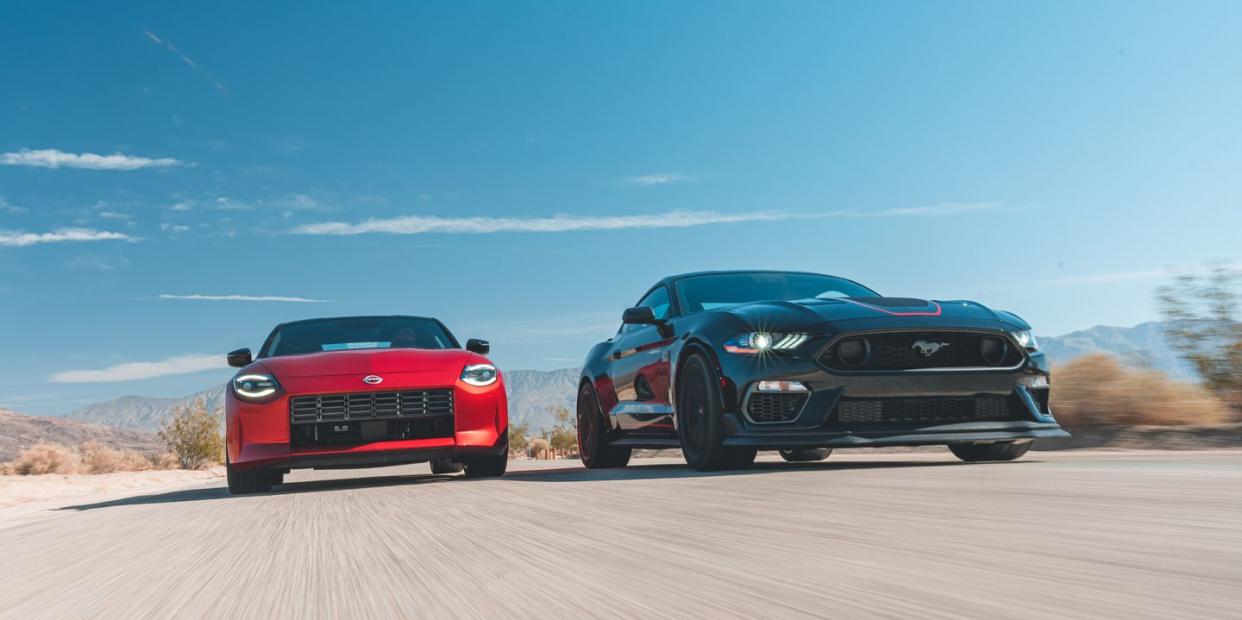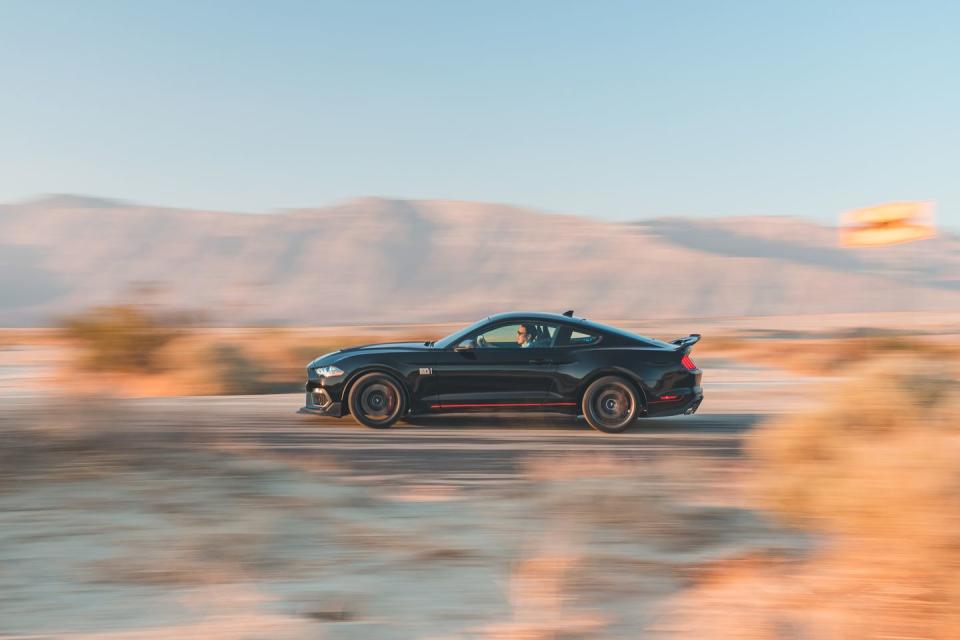Tested: 2023 Nissan Z Performance vs. 2021 Ford Mustang Mach 1

If this was an '80s movie, the new kid, the 2023 Nissan Z, would spend the first half of the film getting pummeled by our bully, the 2021 Ford Mustang Mach 1. Then there would be a montage of the Z lifting weights, running, and doing high kicks—maybe while wearing a cropped sweatshirt and some wristbands—and at the end, it would come back and teach the Ford, and all of us, a lesson about perseverance in the face of adversity. That lesson will have to wait, because while the Z makes a valiant effort, there aren't enough terrycloth sweatbands in the world to help it beat out the muscular Mach 1's deft moves and deep-voiced soundtrack.
The Mustang is playing the role of the rich baddie in this story, and a look at the pricing shows the monetary gulf between the two. You can get an entry-level Z for $41,015, but a Mach 1 requires a minimum of $54,595. (A more egalitarian fight might be between the base Z and the $43,960 Mustang GT Premium.) Our test Nissan was the Performance model, which gets a host of worthwhile add-ons including better brakes, a limited-slip rear diff, shiny aluminum pedals, and wider performance tires. That bumps up the cost of the Z by about $10,000, and our car pushed it to $53,610 with illuminated door-sill plates, glowing two-tone black-and-candy-red paint, and floor mats. Our Mustang had the Mach 1 Handling package, which raised its price by $3750 but earned its keep with gloriously sticky Michelin Pilot Sport Cup 2 tires, a rear spoiler with a cute Gurney kickup, and adjustable strut mounts. It also wore snazzy red brake calipers, which added another $495 for a total of $60,740.

The Mach 1 and the Z really should be friends since they actually have a lot in common. Each can trace its lineage back to the same era (1969-70) and offers just enough throwback design cues to make it recognizable even to non-car people. There's a cliché among classic car folks that everyone has a Mustang story, and the same is true for the Z. Often, people had both, recalling fond times in several decades of Datsuns and Fords. In our modern versions, both cars sport six-speed manual transmissions and promise to make future fond memories with at least 400 horses under their long hoods. The Mustang's 5.0-liter V-8 pumps out 480 ponies along with 410 pound-feet of torque just above halfway up the tachometer. The Z claims exactly 400 horsepower from the twin-turbo 3.0-liter V-6 with 350 pound-feet spread over a wide rev band from 1600 rpm to 5200 rpm.

The Stang dwarfs the Nissan in every dimension—including weight, where the Z is lighter by almost 300 pounds (3507 to the Mustang's 3793). It's also just over 16 inches shorter than the Mach 1 with a nearly seven-inch-shorter wheelbase. Set the two cars beside each other, and you can't even see the Z behind the Ford. This gives the Nissan an edge in the small daily challenges of parking and maneuvering, but the Mach 1 offers more room in the trunk, and it feels more planted and stable when the speedometer needle climbs and the road starts twisting.
2nd Place:
Nissan Z Performance
Highs: Quick off the line, pretty in a parking spot, a compliant road car.
Lows: Tires can't hold on, plasticky interior, miniscule cargo hold.
1st Place:
Ford Mustang Mach 1
Highs: Track-worthy chassis, free-breathing V-8 soundtrack, comfy seating.
Lows: Stiff ride, unexciting interior design, supercharged price.
Wheelbase and width (the Stang is almost three inches wider) are only a small part of the Mustang's advantage in high-speed maneuvering. Its adaptive dampers make a noticeable difference in how it responds in the dives and rises of a mountain road. The Z feels less yielding—it's stiffer and more easily startled. But where Nissan really biffed it is on tire choice. The Bridgestone Potenza S007s are not only smaller, at 255/40R-19 and 275/35R-19, compared to the Mustang's lower-profile and wider 305/30ZR-19 and 315/30ZR-19 Michelin Pilot Sport Cup 2s, they're just not as good. The Michelins are sticky as a broke-open beehive, and while they tend to want to explore pavement imperfections when you just want to go straight, it's worth it for the way the Mach 1 hangs onto a corner like a spider monkey swinging through a forest. It's all confidence, all joy, all rock-kicking rudeness at whomever trails behind. The Z, which is pleasant at moderate speeds, howls and floats once pushed. Get hard on the brakes, and the Mustang stops and turns. The Z slides and complains.

Our skidpad and brake testing backed up the initial impressions. The Mach 1 pulls a stomach-twisting 1.06 g's, while the Z can't make the circle with more than 0.93 g. The Ford came to a stop from 70 mph in 138 feet, whereas the Nissan took 166 feet to whoa down. If your goal is to ruin the day of tourists in your local canyons, the Mustang is the more intimidating machine, not just because it will come up in their rearview like a sudden summer storm, but because it will do it with all the accompanying thunder. Turbos may be an efficient way to make horsepower, but nothing sounds like a free-breathing V-8. It's a roll-the-windows-down-and-seek-out-tunnels sound. The Z doesn't even come close. It's almost silent, disappointingly enough that we felt bad for the kids at an overlook who asked to hear it. Their faces clearly said, "That's it?" Look kid, it will be a better car for sneaking home late. You don't sneak anywhere in a Mach 1.

There's no clear winner in exterior design, as both cars are undeniably good-looking machines that you'd be proud to park in your driveway. Visually, we'd give Nissan more points for its interior, which at first glance is uncluttered and appealing, in a flashy two-tone. The Mach 1's looks like a Mustang interior: old-fashioned at this point and utilitarian. Settle in and start touching things though, and Ford gets an unexpected win on material quality. The Z feels cheap, from the flimsy door handle to the S-mode sport button, which for inexplicable reasons needs to be pressed and held to activate Sport mode and the rev-match function even though it allows quick presses that do nothing. The Mustang might not look as good inside, but at least everything feels firmly attached, and if you want it to blip for you, it's a menu option that stays on or off until you change it again. The Mustang also makes up for a harsh ride quality with a plush seat that cushions the bumps while still offering support in the turns. The Nissan's ride is a little more compliant, but its seat cushion is considerably firmer, making the Mach 1 more comfortable overall.
Despite what appears to be a runaway win for Ford, the Nissan does make a good showing in the final matchup. Set these two up for a drag race, and the Mustang's big power and extra torque do nothing for it. Both cars offer launch control and no-lift shift, and each hits 60 mph in 4.5 seconds. But then the Z noses ahead to clear the quarter-mile in 13.0 flat, compared to the Mach 1's 13.1-second run. It's not enough to make the Nissan the hero of this story, but it does give it some dignity, so maybe the Mustang won't push it around for the rest of the school year. The lesson in this movie may be that you don't always manage to win over the popular kid, but if you have a rear-drive, stick-shift, retro-cool coupe, you'll have an awfully good time trying.

You Might Also Like

